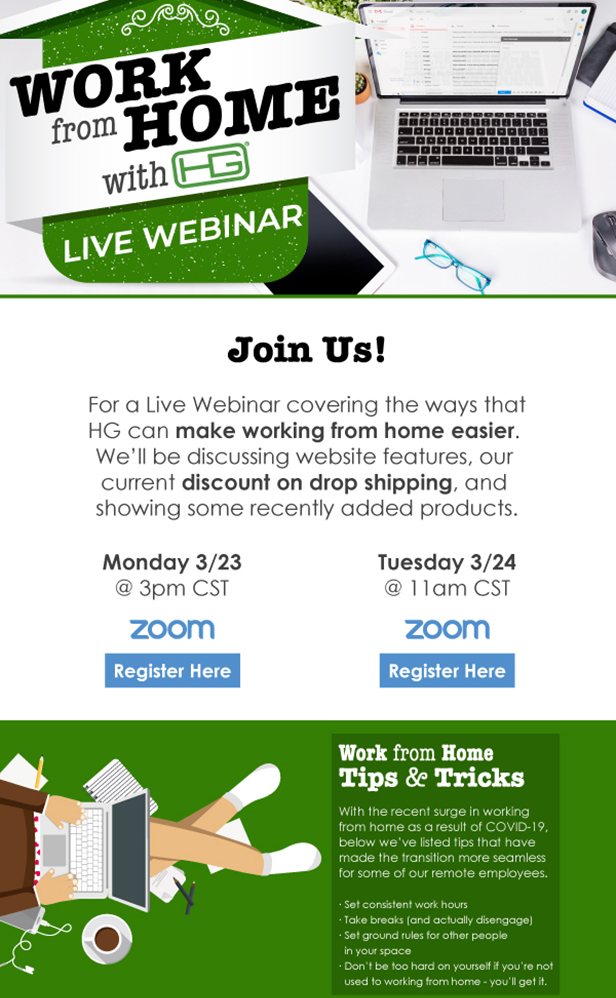March 19, 2020
How to Conduct a Webinar
Tips for choosing the right software, properly promoting and giving your best performance.
As we continue “social distancing” during the coronavirus pandemic, companies are looking for new ways to keep in contact with clients and employees.
One of those alternatives is a webinar, an interactive online video presentation. It’s a popular tool – 73% of B2B marketers and sales leaders say a webinar is the best way to generate high-quality leads, InsideSales reported. Several promo firms have already considered conducting webinars for internal communication between employees working from home, as well as engaging with loyal clients and potential customers.
Here are the steps to get started:
Choose A Platform
There are a variety of webinar software platforms, such as GoToWebinar, Zoom, Adobe Connect, BigMarker, Livestorm and more. They offer a wide range of features, including screen-sharing, recording, phone dial-in and chat. Pricing and accessibility vary for each service, so you’ll have to shop around for what’s best for your budget.
GoToWebinar offers a free seven-day trial, but its basic plan costs $49 a month and holds up to 100 participants for webcast only. Zoom has a free basic tier that allows you to host up to 100 participants, but there is a 40-minute limit per session (average webinar length is 55 to 60 minutes). Livestorm also has a free basic tier with restrictions of 10 participants per webinar and a 20-minute limit. Adobe Connect’s basic plan costs $50 a month and holds only 25 participants max. BigMarker’s starter plan costs $79 and holds up to 100 attendees.
If you’re looking for free options, Skype and Google Hangouts are available. Skype (50 people max on a call/video) lets you record, save and share your sessions, and even provides live captions and subtitles. Google Hangouts Meet (25 people max on a video) is a videoconferencing tool integrated into the G Suite platform that allows people to hop on meetings via a web link through their laptop or mobile app. If your organization uses G Suite, you can create that link directly through a Google Calendar invite.
Another free, less conventional option is Facebook Live. You can do it on your phone, there’s an unlimited number of live viewers and the chat function is easy to use. Plus, the video is automatically recorded and exists on your Facebook page after streaming.
Prepare Content
Before you start streaming, you need to determine the purpose of your webinar. Are you looking to generate sales leads, sell a new product, inform customers or employees of company updates, etc.? If the content is aimed at clients, ask your sales team if there’s any information they want presented. If the webinar is for internal purposes, check with HR to see if there’s anything they want shared. Whatever topic you decide, make sure it’s specific and SEO friendly. Frame the title in the form of “How to …” for maximum results. Once you have the topic, create an outline of what you’re going to talk about for the next 40 to 60 minutes.
Promote Your Webinar
You need people to register for your webinar, or at least tune in on time if you’re doing Facebook Live. Create a landing page on your company website that will encourage people to sign up. Give a brief explanation of the topic and what viewers will learn. Announce who will be hosting and highlight the date and time of your webinar. (With most folks stuck in their home right now, the day of the week doesn’t matter as much. Between 10 a.m. and 2 p.m. is still the preferred timeframe.) Mention it will be recorded, so that if people can’t attend, they can still register to receive the recording later. Have them leave their name and email and include a call to action (CTA) – the word “register” should be fine.

Promote the webinar registration form on your website, through social media and in an email blast. Email campaigns drive 57% of webinar registrations, according to GoToWebinar, and 36% of registrations occur between 8 a.m. and 10 a.m. Send your email invites early enough that they’ll be at the top of your recipients’ inboxes when they start their day. Planning ahead is crucial – 59% of registrations occur less than a week before the webinar and 17% occur the same day.
Check Equipment
Make sure you have a camera (a working laptop camera is good enough) and a working microphone with settings adjusted to the environment you’re in. It may be impossible to have no interruptions while working from home, but try to stream in a quiet place. Check if your internet connection is stable and that your laptop charger is plugged in. If you’re going to share your screen, don’t have any unnecessary tabs open in your browser.
Performance Tips
Don’t rely on slides and charts – increase your personal presence. Be energized. If you’re laid back and passive, it will carry over to your audience. Leverage your voice – vary your volume, range, pace, emphasis and pauses. This will keep your listeners more engaged. Summarize after every concept or major point to emphasize the importance to those listening or to those who had to step away from the screen and missed out. At the beginning, mention that you’ll answer any questions at the end, and then leave enough time to accommodate all your viewers.